The Actors’ Chapel St Stephen on the Cliffs North Shore Blackpool 1928
As the suspicion of the Church towards the stage persisted, the Actress could always say to the Bishop with innuendo, “…..”
The creation of an Actors’ Chapel within the church of St Stephen’s in Blackpool reflected the still evident conflict in some areas within the Christian church against the acting profession. It demonstrated the two sides of the argument represented on the one hand by the perceived purity of religion and the equally perceived material wickedness of the theatre and anybody involved in it, and on the other hand by those of a more liberal and modern mind who would embrace the actors and actresses within the church. There were those whose roots were firmly glued onto an unbreakable faith and who would perceive the stage as profligate and evil, and opposite them, free of that glue and of a more liberal mindset, those whose ideas of life embraced the honest and moral endeavours of others whatever their creed or the nature of their work. In an article in the Blackpool Times of September 15th 1933 while describing the irony of the continuing opposition of some members of the clergy against the modernism of accepting with open arms the numerous members of the acting profession through the doors of St Stephen’s on the Cliffs in the town, and no doubt referring to those former Miracle Plays claims, ‘It cannot be too strongly insisted, as a verifiable historical fact, and not a piece of sentimental posturing that the Church of the Middle Ages was the mother of English drama.’ Or elsewhere it is quoted, regarding the innovative, annual actors’ church service, ‘This service has done much to break down the barrier between the church and the stage, yet there are still many people today who believe the church and the theatre are directly opposed. They look upon the actor or actress as an unclean and immoral person.’ (Lancashire Daily Post September 17th 1934).
The Chapel was quoted as being the only one of its kind in England, or even the world, but this would refer to its function rather than its concept as other actors’ chapels existed, at least in name, prior to its eventual creation in 1928. At St Stephen’s-on-the-Cliffs, special actors’ services, as would be the specific function of the chapel, had been conducted in the original church on the site by its energetic and sympathetic founding vicar, the Rev Frank ‘Freshy’ Freshwater, since 1919.
The Actors Chapel function.
While there had been a special actors’ service from 1919 in the original church of 1911, this grew in popularity and a special actors’ chapel was constructed in the new church in 1928. Here there was a weekly a service on a Thursday morning for actors (for which, read actresses, too), and an annual celebration in September which was attended by actors from all over the world. The annual service in September, the anniversary of the dedication of the chapel, represented a kind of actors’ convention at the event, which spilled over into the vicarage later. At this time the church would swarm with members of the acting profession from stage and screen, from call boys and scene shifters and everything in between and including singers and dancers, writers and producers, clowns and acrobats and anyone who was in work in any one of the many venues of the town at the time.
In the circus season all the circus personnel would make the ‘pilgrimage’ to the church. Canon (a title created in 1937) Freshwater, the actors’ chaplain and friend, was quick to be at the side of an injured performer and also always there to be a referee in an argument, or to cure or advise, or sympathise in a divorce or difficulty in a relationship. Or a ‘beautiful chorus girl’ who has got into difficulties ‘in one way or another’ as the newspaper report obliquely put it as, in the mutual equality of sexual union it is the female that has to take the physical and social consequences when infanticide and suicide, or both, were, in despair, deemed the only solution for some unfortunates. Each and everyone could go and have tea with the vicar at St Stephen’s and talk over their problems, to be received by a sympathetically listening ear. The visitors’ book, which everyone was encouraged to sign, is a historical wealth of the names of actors and actresses in which Dame Sybil Thorndyke reflecting the sentiment of any actor who visited writes, ‘I always love coming here.’ Even Mae West, the actress whose on screen language of innuendo differed from any kind of language used in a church sermon is reported as having signed the book (and this yet needs confirming). Non church-goer Edgar Wallace who once stood for Parliamentary election at Blackpool was a frequent visitor to the vicarage.
The Actors’ Chapel at St Stephen’s is always billed as the first and only one of its kind in the country, though there is a reference to an Actors’ Chapel in Soho Square in London in 1927 and which had been in service for nine years before that date. This was attached spiritually, rather than physically, to the Actors’ Church Union and had been created from a former coal cellar. It was sparsely furnished with an altar and three small armchairs and a harmonium to accompany or lead the singing. Perhaps the unique nature of the chapel in Blackpool in 1928 was that it was an integral part of the church interior.
There might have also been the germ of an influence with the death of Rudolph Valentino in the August of 1926. While the regular male might have swooned over the exposure of the shape and form of the pre-code Hollywood female, it was in the demise of a male icon that the regular female, in demonstrating, conceivably, an excess of regular emotion, swooned, fainted, fell under horses and broke a stained glass window in the crush to take a view of his body as he lay in state at the Broadway Mortician’s Chapel in New York. The funeral itself would take place at the Actors’ Chapel of St Malachy’s Church, New York on the 30th of August giving the Actors’ Chapel a worldwide publicity. The same Catholic actors’ community was providing a mobile motor chapel in the State of Oregon in 1927 so the time was approaching when the gap between Christian church and the acting profession was narrowing almost to the point of shaking hands in friendship. In 1932 The Actors’ Chapel at St Malachy’s church was also the setting for actor Frank McGlynn’s son’s first mass as ordained priest. Frank McGlynn we learn being famous for portraying Abraham Lincoln and continuing in film with another son of his. The vicar of St Stephen’s, Rev Frank Bertram Freshwater, a chaplain of the Actors’ Church Union, had already conducted ‘church and stage’ services for actors for a number of years and these had also become well known throughout the world. By 1927 positive steps were being taken to construct the specialist chapel. After the successful ‘Church and Stage’ service on 4th September 1927 which succeeded the construction and consecration of the new church building, when there was music provided by Herman Darewski, active dance band leader at the Winter Gardens in the resort, the actors present on that occasion from all over the world thought it appropriate that St Stephen’s, with its energetic and sympathetic vicar, would be the ideal place for a permanence of the idea of a dedicated Actor’s Chapel. The town was second only to London in the world of theatre and music and Blackpool is a place where people come to rather than belong to by birth by ratio of population so in that respect, the chapel would have a world wide relevance. There is also a reference to an Actors’ Chapel in St Paul’s in Covent Garden on the death of actor Dennis Neilson-Terry, an original subscriber to the Blackpool Actors’ Chapel fund, and whose body had been brought back from South Africa where he had died while on tour in 1932.
While the new church, to replace the former building of 1911, had cost about £36,000, (£1,765,372.51; 2023) in 1927, there was no lack of desire to begin more fund raising for the dedicated Actors’ Chapel to be constructed in the church at St Stephen’s. The scheme would cost about £600, (£30,403.64; 2023) and those subscribers who donated more than a guinea (approx £53 in 2023) would have their names engraved on the white marble panel of the altar piece. This altar of white marble and alabaster will be decorated in relief with figures of dancing and music reflecting the biblical episode of David triumphantly entering Jerusalem with the Ark. As well as David, St Cecilia, as patron saint of music, would also be represented in the Christian tradition. By 1933 there were 600 names engraved and space would have to be made for more as donations in money and articles continued to arrive over the years. A new marble floor to replace the existing floor had been unveiled in February 21st 1937 in memoriam after the death of Mrs ‘Mother ‘ Jenny Tiller, the previous year, a matriarch cherished by all the dancers, and this had been achieved with contributions towards the expense from Tiller Girls and dancing troupes ‘all over the world.’ And the Tiller group of eight led by London girl Barbara Aitken was present at the unveiling. In the same article of the Blackpool Times of September 15th 1933 quoted earlier continues, ‘It is fitting that such a chapel should be placed in Blackpool, whose principal entertainment – and industry – so important to the town that in Mr Freshwater’s words it is “almost Blackpool’s soul.”’
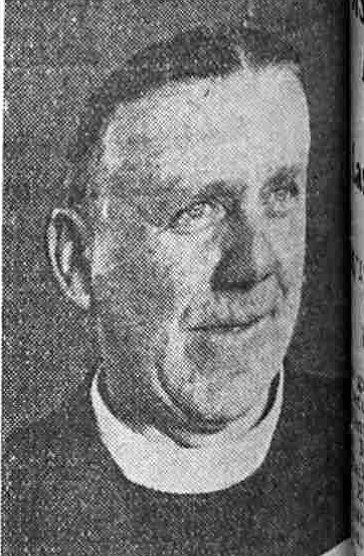
Reverend (later Canon) Frank Bertram Freshwater. Blackpool Times September 15th 1933. ‘This Actors’ parson is a man of attractive and magnetic personality, and his popularity is not difficult to understand.’ (John Bull Oct 30 1937). And in concluding the same article, ‘The dream of Canon Freshwater has come true. Nor is it surprising that this bluff and hearty man of God is well loved by members of the ‘profession.’’ It is to be expected that his earlier experience in training in law before he took to Holy Orders would have helped his path through the controversy he would meet in fulfilling his ideals.
The following three photographs are presented with the kind permission of Robert Leach, also administrator of the History of Blackpool facebook site.
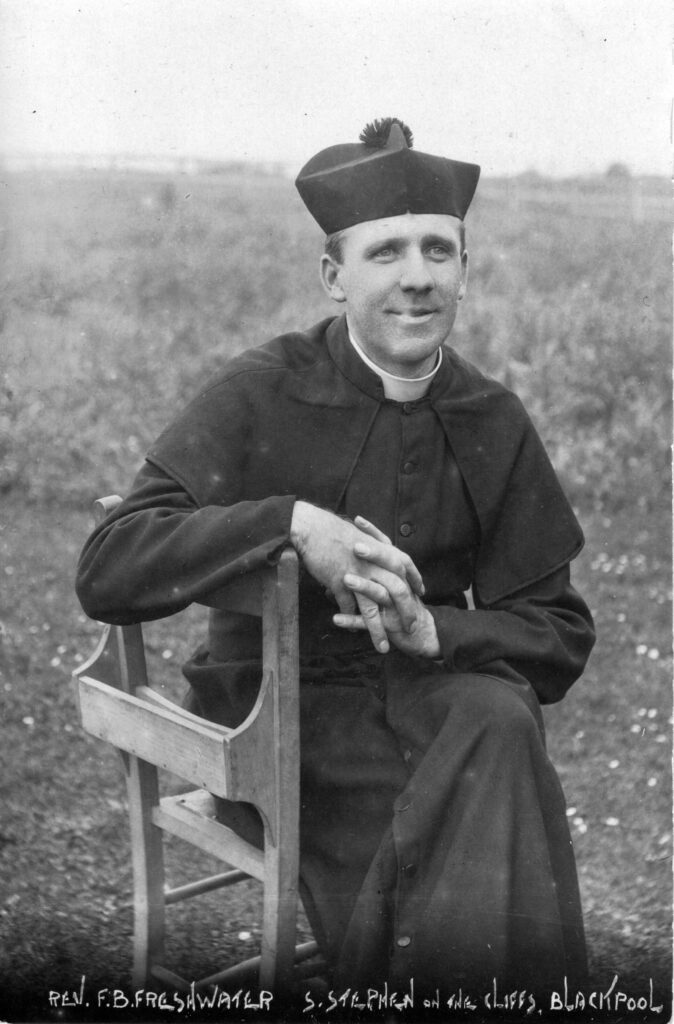
A younger Reverend Freshwater posed on a seat borrowed from the church (below)
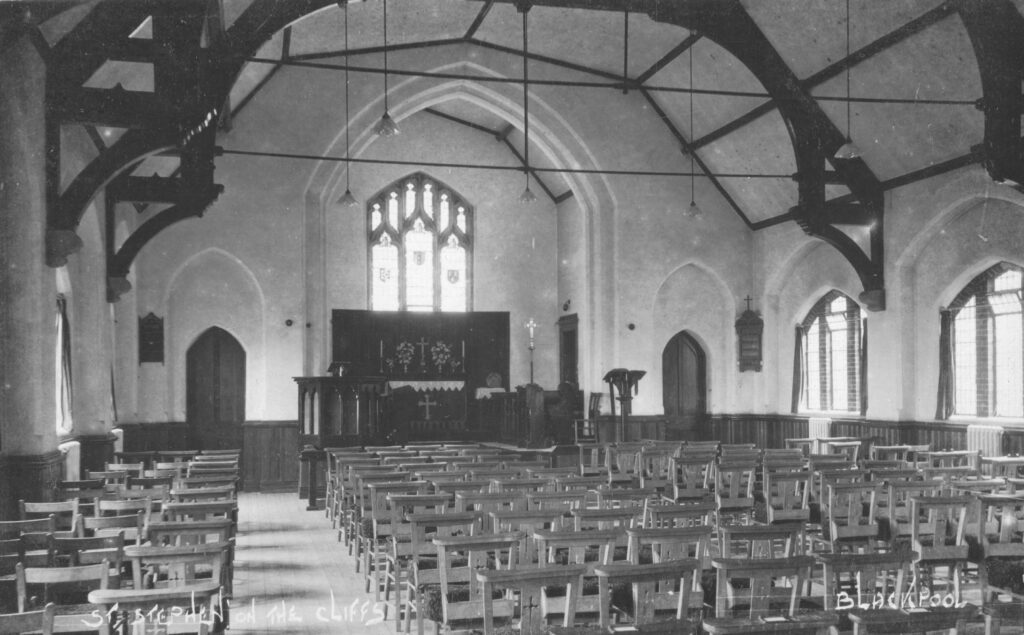
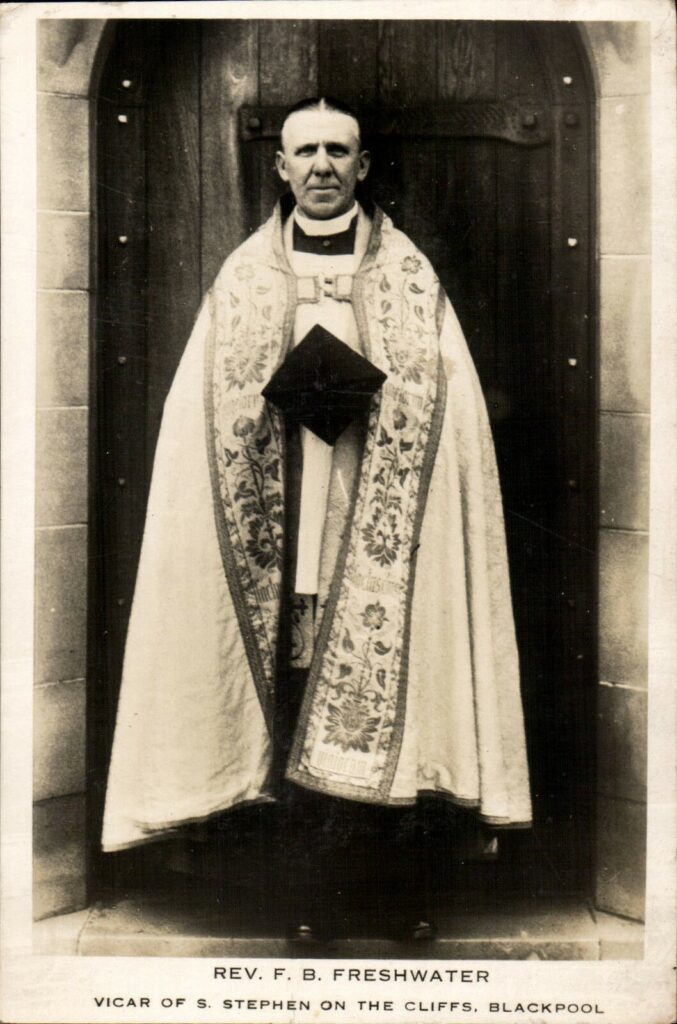
An older Rev Freshwater in chasuble.
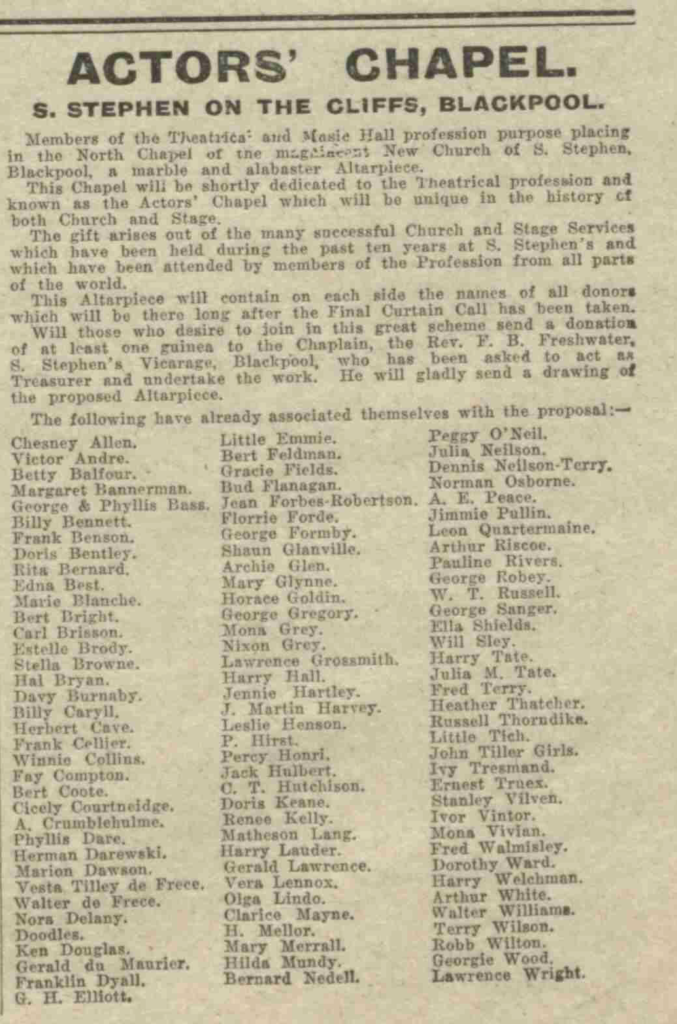
The Stage February 16th 1928
The dedication service of the Chapel took place on September 22nd 1928 and was attended by numerous members of the acting profession. The congregation consisted of a variety of entertainers including clowns, ‘midgets’, (performing as a curiosity at the Tower in a concept unacceptable today), tragedians, comedians, ventriloquists and dancers mostly from the local theatres. The Tower Circus clown, Doodles, (Scotsman, William McAllister) and Fred Walmsley comedian, along with Jimmy Pullin from Feldman’s theatre entertainment in the town, acted as sidesmen. Others active in the service were, Norman Long and Walter Williams from Lawrence Wright’s North Pier, ‘On With the Show’, Victor Andre and Charlie Naughton. The mayor and mayoress of Blackpool, Mr and Mrs Lumb were also present. Herman Darewski and his band were dressed casually in flannels, breaking dress tradition as it was generally considered inappropriate for a church service at the time, provided the music with saxophones, sousaphones, banjos and drums and the music played included, ‘War March of the Priests’, ‘War March of the Prophets’ and a specially composed piece of music by the band leader, ‘The Holy Shrine’ so mostly quite a militant sentiment from the acting profession and those allied to it.
On the unveiling of the reredos the bishop’s words were, ‘I declare this chapel, thus adorned by members of the theatrical profession, shall be known henceforth as the ‘Actors’ Chapel’’ The unveiling of the altar itself was performed by actors Owen Nares and Gwladys Stanley. The Bishop of Blackburn, of the regional diocese, was pleased to admit that this Actors’ Chapel was ‘a manifestation of the new-found fellowship between Church and Stage.’
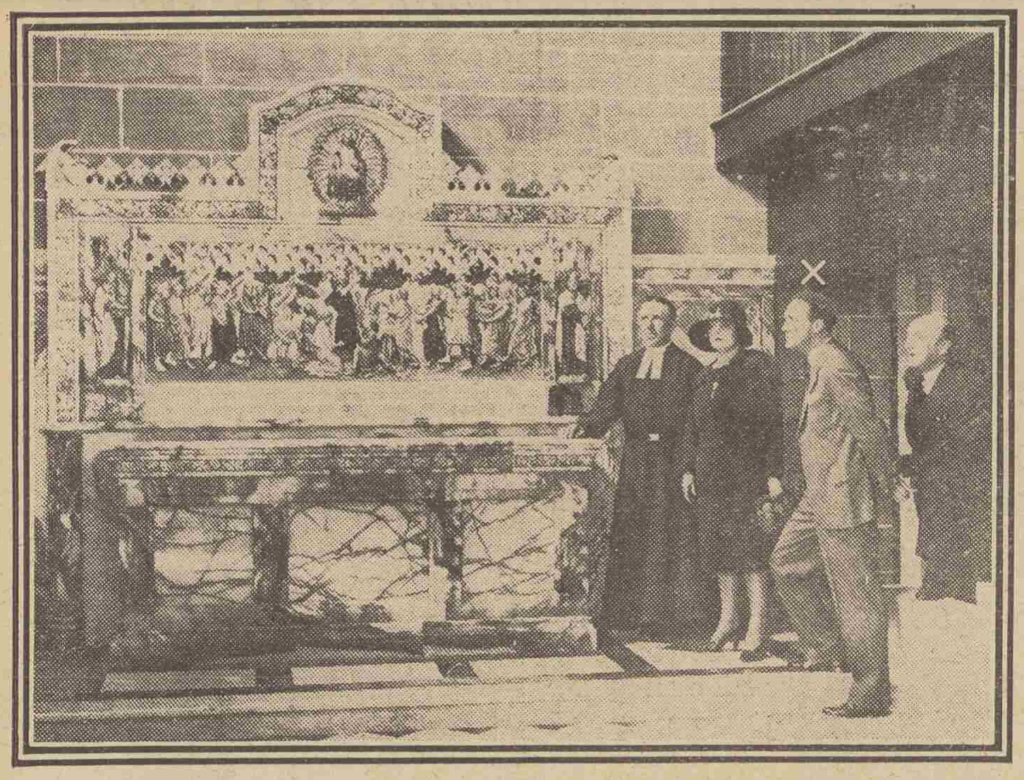
OWEN NARES UNVEILS ACTOR’S REREDOS. The Daily Mirror September 24th 1928. ‘The reredos depicting strolling players, unveiled by Mr Owen Nares (x) in an actors’ chapel dedicated by the Bishop of Blackburn at St Stephens-on-the-Cliffs, Blackpool. Others in the picture are the vicar, the Rev. B. Freshwater, Miss Gladys Stanley and Herman Darewski, whose band provided the music.’
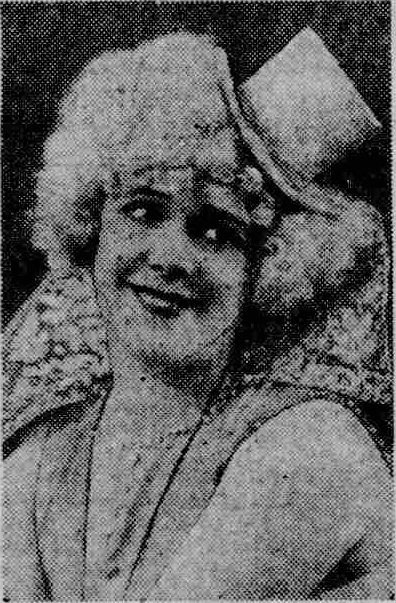
Gladys (Gwladys) Stanley in less formal attire. Evening Despatch September 18 1931. Mrs Gladys Stanley the revue actress who would have to undertake 14 changes of clothes during each performance of ‘Say It With Laughter’.
Interviewed by the same paper in 1931 when the correspondent was in Blackpool, the Rev Freshwater is quoted as, ‘The church is slowly but surely beginning to love the stage, beginning to recognise a brotherhood with it, and wanting to work hand in hand. There are possibly bigoted, so-called Christians who think that every actor and every actress is wicked, and that the stage is a sink of evil; but it is a lie to be thrust down the throat of any man who has the presumption to think it, let alone say it. What class of people have bigger hearts, are more, and more given to good work?’
In 1935 the Sunday Mercury of 15th September reports that the Bishop of Bradford, (Dr A. W F. Blunt), president of the Actors’ Church Union will preach to a congregation of Chinese, Hungarian, French, Russian, German, Cuban, Mexican, Viennese, English and Scottish artistes – dancers, circus performers, pierrots, and actors from every show now in Blackpool.’ At this time the music was provided by the Bertini and the Larry Brennan bands with the Tower organist Reginald Dixon at the organ at the beginning of his long service at that venue. The regular sidesmen would continue to be Doodles, the circus clowns and current comedians from the town’s shows. This was the regular content of the congregation from as far back as 1919. And by 1941 the chapel had been visited by the president of the Actors’ Union, the Bishop of Bradford, the vice president, the Bishop of Blackburn and the chairman, Canon Richardson.
In 1934 his sermon of the Rev Freshwater has a section to promote his own interest in Christianity as being ‘the highest act of worship’ but it nevertheless follows the paths of most religions or collective human interests in showing a concern and compassion to others and, in particular at this time, a concern for the acting profession as regarding unemployment. The coming winter pantomime season would employ many of the actors present but there are many who would be out of work and for this he blames the ‘talkies’ which indeed were providing another form of entertainment that was in competition with the stage. There was also the fact that amateur shows were very popular, perhaps because they cost less or nothing at all, whereas a professional company might leave the town hardly able to pay for the use of the theatre.
In the sermon of 24th of September 1939 at the church, with the war years once more looming, and worth a mention in the Stage publication, the Bishop of Blackburn spoke of the ‘valuable services that members of the theatrical profession will be called upon to perform in the difficult days ahead,’ and ‘I would have you regard your work as a not unimportant contribution to the welfare of the nation.’ Doodles and the circus clowns were once more present and the orchestra was conducted by William Ure of the Tower Circus orchestra. Those most noted in a crowded church were George Formby whose blue plaque at his former home now overlooks the sand dunes at Fairhaven a little to the south of Blackpool and there was Lawrence Wright, showman, song writer and music publisher whose home at the time was the ‘Castle’ on North Promenade, close the church itself.
So the acting profession, it was claimed by the more accepting members of the church, was not peopled by profligate satyrs and whores, and the clergy in Blackpool, including Frank Freshwater’s good friend Canon Little at St John’s in the town who was no unnecessary apologist for the town, were keen to dispel the reputation held in some areas of nervous morality within Christianity that Blackpool was just a ‘Sodom and Gomorrah’. The value of the acting profession was an essential role to reflect the nature of current society, to create a reflective thought in the audience or merely to assuage with humour and entertainment, a distraction from the devastation of wartime, or in peacetime, to forget, for a moment, the long weeks of hard, continuous work that the audiences were subject to when not on holiday in the resort or anywhere else these actor and actresses might be performing.
At one time, Blackpool, being outside London, was a place where the performance of a ballet was looked down upon as exposing the inappropriate skimpiness of dress and (in a man’s world) not the place to take your girlfriend. There were even resignations tended at the Winter Gardens on the introduction of the daring undress of ballet by adventurous manager Bill Holland before the turn of century not that long ago before actors were welcomed into the church by the likes of Frank Freshwater. Times change and by 1929, the children’s ballets of Pauline Rivers and the Chapel were visited by thousands of holiday makers annually, and postcards of the chapel could be bought for a matter of pence.
But the church and its chapel and its vicar were not only criticised for warmly embracing the acting profession in all its perceived immorality but also for its expression of Anglo-Catholicism in the church service itself. A bit too close to Rome for some and Reverend Freshwater’s church was the scene for a little controversy on 3rd March 1930 when two activist members of the Kensitite Wycliffe Preachers contrived a disturbance in the church, bursting in during the communion service and shouting, accusing the vicar of blasphemy. To this sect of belief, the communion service was seen to be too Anglo-Catholic and it was commonplace for this sub-section of Christianity to object vocally at the churches which were perceived as subscribing to such a union of ritual. At the outset of the incident when the two men had entered the church, the verger, who would have been at the time, the ultimately tragic suicide Thomas Avery, rushed to a house to telephone the police. When the police arrived, there were the usual accusations and counter accusations of the level of physical restraint used and whether it constituted violence or not and they were eventually led away to a tram, as the means of transport into custody, one hand held by a policeman and the other hand on the collar in classic style. It was low key policing in contrast to the screaming sirens of today. The two men were up before the magistrates the same day charged with, ‘At St Stephen’s Church, North Shore, Blackpool, being a place of worship within the meaning of the Place of Worship Registration Act, unlawfully did disturb a preacher duly authorised to preach therein.’ The men, for all their act on their real life, impromptu and unannounced stage, were found guilty of the offence and bound over for twelve months in the sum of £5, (£263.62; 2023). And more than that, the angry audience in the shape of the congregation and parishioners wrecked the van that they had parked outside and the sides were plastered with posters for the building fund of the church which was heavily in the red. Indeed Rev Freshwater had come close to a nervous breakdown in writing a thousand letters by hand in appealing for church funds and had been advised by his doctor to slow down. The incident hadn’t been the first time it had happened to Rev Freshwater as he had recently been subject to their disapproval while preaching in nearby Poulton, and once more during the communion service there.
But for those who possessed a positive and constructive attitude to the church, regular contributions to the chapel arrived at various dates by generous benefactors connected to the acting profession and in the January of 1930 a stained glass, memorial window dedicated to both John Tiller, founder of the Tiller Girls Troupe of dancers and Mr John Huddlestone a former and long standing manager of the Winter Gardens, once both good friends and now both deceased was unveiled by John Bickerstaffe chairman of the Tower Company. The window was presented to the chapel by the widows in memory of both the deceased men, and installed in the Actors’ Chapel. The window had been designed by Scottish-Danish, eccentric artist Baron Airild Rosenkrantz. On Mrs Huddlestone’s (OBE) own death in 1933, she left £50 (£2,886.42; 2023) to Canon Freshwater to place flowers in the Actors’ Chapel. Gifts and donations continued to be provided by appreciative or obliged members of the church.
A processional cross and an altar cross were donated at this time and a statue of the Madonna was later presented by Tessie O’Shea. In 1933 these gifts extended beyond Christianity when a ‘beautiful pair of Indian brass candlesticks’ were presented by Rasheeda Puksh wife of the Kadir (as printed in the newspaper) of the Indian entertainment at the Olympia in the town. Rasheeda Puksh is Mohammedan, so the gift might represent an act of pure friendship and appreciation or natural, worldwide and extended ecumenism.
But while the world is never free of controversy as multiple beliefs and opinions persist and sometimes levels of horrific violence are resorted to in the cause of self-justification, happier times are the more usual. Bequeaths continued to be left to the church and in 1930 the annual Rose Queen crowning was inaugurated. In 1931, on the last day of July, Gracie Fields, one of the original donors to the chapel fund, unveiled additions to the Actors’ Chapel, when crowds waited outside for a long time to catch a glimpse of her. The same year an annual service for the deaf and dumb was inaugurated at the church. Weddings are a natural function of the church and which included Rev Freshwater’s own marriage in 1929. He conducted the wedding service of two ‘midgets’ from the Tower or, the more respectful, little people of today, when miniature Shetland ponies drew a little carriage to the church and another couple married the following year on 10th Sep 1930. ‘She 4’2” and ‘he of normal height.’ Jack Hylton’s sister married at the church in December 1931 and the forever young Little Emmie married there in November 1939 after the death her mentor Pauline Rivers. Both Pauline Rivers and Little Emmie were original contributors to the Actors’ Chapel fund as was Vesta Tilley whose impresario husband she would successfully encourage to become MP for the Blackpool constituency. On the 10th June 1939, with the clouds of war darkening the skies, the organist at the church, Mr E H. Carpenter was present to play the music for his brother’s wedding. His brother, deputy electrical engineer to Thornton Cleveleys Council, Mr H Carpenter to Miss Marjorie ‘Winnie’ Norwood. The ceremony of course conducted by Canon Freshwater. In 1948 the wedding took place between Tiller Girl Shirley Peters and Len Marten, the crazy gang star of Charlie Chester’s ‘Stand Easy’ Show. In August 1940 Manchester born actress Pat Kirkwood married Jack Lister the business manager for Jack Hylton.
In the May of 1932 Rev Freshwater invited Vivian Foster the Vicar of Mirth, whose act was to replicate the homilies of a vicar, but with a respectable twist of humour which would have been acceptable to someone like Rev Freshwater and to those who were not averse to an acceptable caricature. Some recordings of the Vicar of Mirth are available on Youtube. The idea of inviting Vivian Foster was to open the Sale of Work in the continuing strive to pay off the building debt of the church. In the same year a Christmas performance entitled ‘The Golden Image’ containing 80 actors took place ‘for the first time in a place of worship.’ Rev Freshwater, among several responsibilities, was also chaplain to the Blackpool branch of the RNLI and a special service was held in the church in the April of 1933 when the long serving coxswain Harry Parr read the lesson and the service became an annual event. The stormy seas and its insidious sandbanks off the coast are indeed a danger and it takes a brave individual to challenge them in times of rescue. The lifeboat crew had their own band so were not unused to playing music in public and occasionally provided the music at the annual service.
In January 1934 in his indefatigable efforts to ally to the acting profession and to keep funding moving the church debt steadily towards the black, he arranged a dance competition at the Winter Gardens and in May 1937 the evening service was broadcast by the BBC for the second time. Then as the acting profession and the church had largely become friends, its purpose accomplished, the chapel began to lose it focus and import, and as society changes, too, the chapel, though still relevant, eventually falls into obscurity. The Rev, later Canon, Freshwater continues his ministry until his death in 1950 after which the Rev Geoffrey Gower-Jones from St Anne’s church Belfield, Rochdale became the vicar.
The church though, still maintained its good relationship with the acting profession and the arts and in 1951 it was suspected that the actors church might become something of an art gallery as a painting by Guido,’ St Michael and the Devil’ was on display there. In 1953 the vicar, Gower Jones, Canon Freshwater’s successor, displayed the selflessness and responsibility of duty of a man of his calling when though he had a cup final ticket (Blackpool’s winning cup final year after two previous final defeats) he didn’t go to Wembley and stayed behind instead to fulfil an engagement with the Burnley Deanery Mother s Union. Some might consider this as the ultimate sacrifice.
In 1955 St Stephen’s was still considered the Actor’s church, though perhaps for reasons of space a television religious service (Epilogue) was conducted by the current vicar, Rev Gower-Jones, at the Norbreck Hydro a little further north up the coast and in 1956 the actors service is still being held and in 1964 Lawrence Wright was received into the Actors Chapel on his death. In July 1970 the funeral of actor Arthur Leslie, Jack Walker from Coronation Street, was conducted at the church which more than 2,000 people had attended including cast and crew of the production. And in 1996 the funeral of Little Emmie (Emma Coates, born Tweedale) who had reached the age of 97 took place at the church.
Today St Stephen’s is quieter than its glory days but still holds the memories and the treasures of its heyday in its artefacts left by the acting profession, and the memorials and ashes of some of its supporters. The visitors’ book with its wealth of signatures is, I understand, now appropriately, and jealously, guarded under lock and key.
The church possesses a blue plaque unveiled in 2011. At present in the spring of 2023 the church is in a less photogenic state, dressed in scaffolding and undergoing essential repairs.
…. and thus with the union of church and stage today, the Actress can now say to the Bishop confidently and without any innuendo at all, ‘……’
Canon Frank Bertram Freshwater
Founder of both the church and its chapel Canon Freshwater’s interest in the theatre only appears to have developed after he was posted to Blackpool and a sympathetic nature to the acting profession once developed, he was no doubt inspired to inaugurate the annual actors’ service at the church.
He was born in Hulme, Manchester on October 25th, 1879, though the census return of 1881 gives his birth place, in the tired handwriting of the enumerator, as Preston. If that is the case, he is nevertheless soon in the bigger city as the family address is York St, Hulme, Manchester on that census return. By 1891 Frank is still in Manchester living at boarding school on Alma Road with an aunty as headmistress and a sister as a teacher. He began his working life in the hardware trade but by 1901 at 22 years old he is a law clerk living at home at 81 Clifton Street in Stretford. Next door is a Baptist minister who may have had some influence on Frank’s change of career and he was ordained on the 8th June in 1904 in Manchester Cathedral. In 1911 he is living with his widowed mother at 233 Manchester Road, Bury where he is at first a curate at St Peter’s, keeping a lasting friendship with the town and the church there after moving to Blackpool. His co-curate at Bury was his best man at his wedding in 1929 so it was a longstanding connection with the town. In Bury, his first post, he was known as the ‘sporting’ or ‘athletic parson’ as he would always join in the sporting events and he would also become Honorary Major of the Bury Battalion. In 1937 he was appointed a Canon of Blackburn Cathedral.
On his assignation to Blackpool, his task was to create a new church and parish. St Stephen’s Church website has Rev Freshwater already as a curate at All Hallows, Bispham, at this time before being assigned, and has church services being conducted from 1908 and accommodation at All Hallows would be understandable. By June 1911 tenders were invited for the construction of the building. While the church was being considered and constructed, services were held at the nearby Clifton College where, in September the harvest festival took place inside a room decorated with flowers. Occasionally there were services in the open air especially on the cliffs near the site of the proposed church. Fund raising events and meetings took place in the assembly hall at the equally nearby and newly constructed Uncle Tom’s Cabin public house. The first service was held in July of 1911 and the foundation stone of the new church was laid on 5th August 1911 in a ceremony conducted by the Bishop of Manchester when ‘the services in connection with the St Stephen’s Mission Church on the Gynn Estate will be conducted by the Rev F. B. Freshwater, the new curate-in-charge.’ (Blackpool Herald July 14th 1911). On the 11th of the month he had been licensed at St Anne’s church in Manchester to the ‘Conventional District of St Stephen’s, the Gynn, Bispham in the parish of All Hallows, Bispham.’ The first parochial magazine was issued in December of 1911 as the building fund was progressing nicely.
By December, the first of the annual events was held and which was to include a children’s Christmas party and the first church service was held in the new church on Saturday, 23rd March 1912. At this date, the 7th King’s Liverpool (the 8th would later be known as the Blackpool Pals) helped out at a bazaar for church funds.
From this date the popularity of Rev Freshwater increased as his energies in his particular metier of curate-in-charge brought him many friends and admirers. He began to introduce all forms of entertainment to provide church funds and also to provide a social gathering where entertainment brings people together. Fund raisers as bazaars and successful open air events continued to function to raise funds for the building or the debt from borrowing once built. The church soon had its own choir which travelled the district to sing at various events. By November 1913 a bazaar was held in the Winter Gardens as the church building debt stood at £1200, (£111,686.83; 2023). The war years which followed then included the intercession services and extra services for the troops.
Bispham and the Gynn were not part of the municipal district of Blackpool until after WW1. While his task was to create a new parish, the church built in 1912 had become too small and a new church on the site was built and consecrated in 1927. By 1919 there was £2,000, (£83,297.64; 2023) to find for the Endowment Fund in order to make St Stephens into a separate parish and the Gynn Estate, in which the church was situated, donated a sum of money towards this cost. In this year there was a ‘Victory’ revue given on behalf of the church funds at the Winter Gardens. On 24th October 1919 he was elevated to vicar rather than priest in charge. The church organist retired in Feb 1920 and a new organ installed in May 1920.
On 25th July 1925 the corner stone of the new church of St Stephen’s on the Cliffs was laid in a ceremony by the bishop of Manchester. The cost of the church was £36,000, (£1,765,372.51; 2023). A bazaar at the Winter Gardens in May to begin the funding for the new church, was opened by General Topping whose funeral Rev Freshwater would conduct the following year. It was hoped that the first portion of the church would be ready for consecration on Ascension Day (Thursday) in May 1927. The actors’ chapel would be created in September of the following year of 1928.
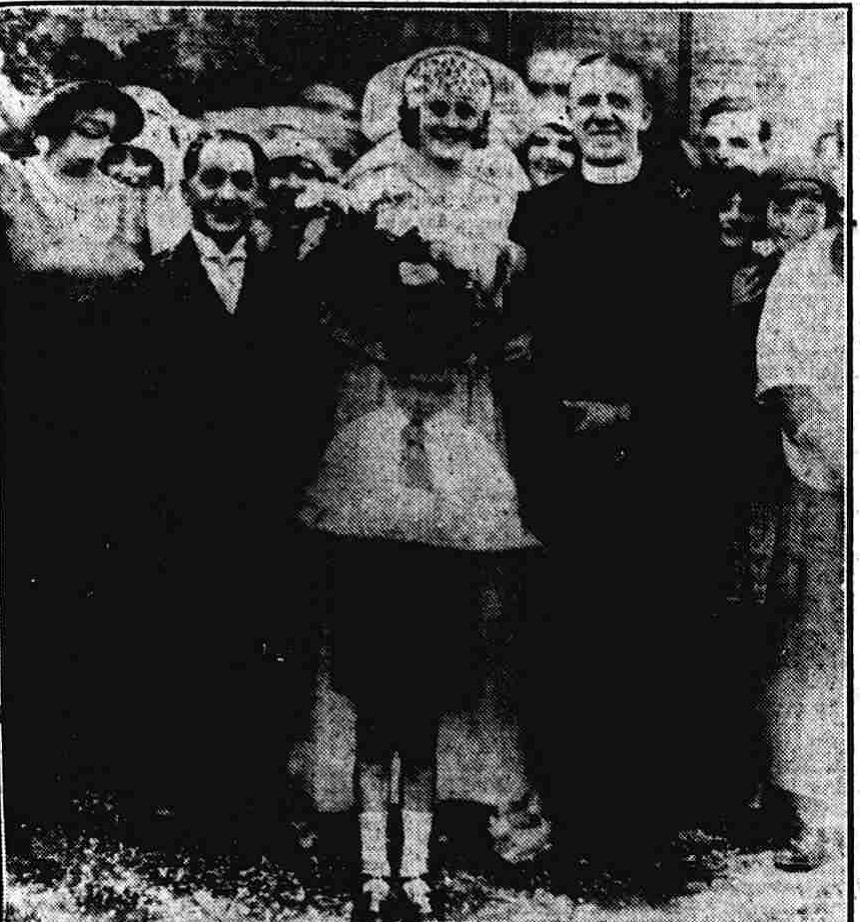
Lancashire Daily Post. September 5th 1929. ‘Left to right; Miss E.G. Read who gave the bride away. Mr W. McAllister (Doodles of Tower Circus fame). The bride, Miss Barbara W. Cuthbertson. The bridegroom, the Rev. F. B. Freshwater, Vicar of St Stephen’s on the Cliffs. Behind the bride’s right shoulder is the chief bridesmaid, Miss Irene Freshwater. Along with her were eight Palace Tiller girls, who acted as maids of honour, and in front is the page, Master Peter N Radcliffe.’ A poor photo as most photos from the newspaper archives don’t reproduce well.
The bride was living in Bispham at the time, but originally from Staveley in Derbyshire and who lived at ‘Hazelhurst’, the house name, on Bispham Road. A lady educated in foreign languages and a BA she had come to Blackpool on holiday several times and it was the church where the two met up and forged a relationship. The marriage ceremony was ticket only and outside the church the surrounding streets were packed with holidaymakers and well-wishers and even a man climbing onto a roof to have a good view. In the new format of declaration and a diversion from former tradition, the bride did not have to repeat the words to ‘obey’ her husband but in a little step further in the progression of the equality of women, ‘To honour, and keep him in sickness and in health,’ which, in that respect, could be regarded as a little better if considered reciprocally mutual. The wedding song from Lohengrin was played by Herman Darewski’s Winter Garden’s band as the bride entered the church and Mendelsohn’s Bridal March as the married couple left. The attire of the wedding complement took seven paragraphs of description in the Lancashire Daily Post with the page boy, a nephew of Barbara’s, dressed in velvet knickers, which in the evolution of language and acceptance of ideas in today’s world would have him dressed in short trousers rather than female underwear which, as velvet, might have been uncomfortable as underwear, anyway. The Dutch cap she wore on her head is similarly subject to the evolution of language. A reception was held at the home of Miss Read in Bispham before the couple left on honeymoon to London. Both Mr and Mrs Freshwater were active in society, Mrs Freshwater in the Women’s institute and Frank was a nominee, though unsuccessful, for the one of the two seats in the Bispham ward in 1919.
However, as strong as his alliance to the acting profession was, there was some showmanship that Rev Freshwater could not comply with. Blackpool’s Golden Mile presented a host of exhibits continuing the fascination with the absurd or the oddities of the grotesque of the human being, from the fad of starving people and vicars in barrels (Rev Stiffkey; de-frocked due to his association with ‘fallen women’, though probably with compassion rather than sexual need or desire), to the woman called Daisy Winterbottom who, in the May of 1939, and classed as the ugliest woman in the world, offered £100, (£5,272.31; 2023) to any man who would marry her, her only stipulations being that he had to be religious and he must not drink. Her father had already tried to get rid of her, so the story goes, offering a £10,000, (£527,230.71; 2023) dowry to any man who would marry her. Perhaps she had become inured to being considered ugly and wanted to make money out of it or perhaps she and showman manager, ‘Explorer Evans’, both saw an opportunity purely to make money in typically uncompromising manner. The local Councillors found it disgusting and Canon Freshwater called it ‘a prostitution of the sacrament of marriage’. Today perhaps the condition of the human individual can be considered with respect outside the protective shell of religion which at one time was its only resort when considered as a creature of God and such extremes are no longer needed.
In January 1939 a veteran of the First War, Thomas Jeff Avery, verger at the church for the last 15 years, committed suicide by walking into the sea by the cliffs at Bispham. He had been suffering from depression, no doubt from a lingering state of unidentified and untreated PTSD from his active service as a stretcher bearer in WW1 when knee deep in mud and defying the flying bullets around the head and diving for cover as the shells burst around him, his duty would have been to take the bandages and the morphine to his stricken comrades, and of course to administer the medical training derived from the specialist courses at Blackpool. Thomas was originally a Birmingham man.
And, as the next war began Canon Freshwater demonstrated that he wasn’t only concerned with spiritual matters for he volunteered for ARP work and in the beginning when the phoney war continued to aggravate, and when someone saw him with an ARP badge and asked him what branch of the service he represented he quickly replied, ‘The Heavenly branch with the ‘ARPS.’ Always a man of energy and humour.
Death
While the actors’ services began to lose their momentum and public press appeal, Rev Freshwater continued his vocational work and church duties but by 1947 he was ordered to take a rest by his doctor. He was naturally slowing down by now and on March 29th 1950 he died at Victoria hospital in the town. His funeral, packed to the doors and even outside, took place at St Stephen’s Church on April 3rd. Many actors were present and the mayor and Council members were dressed in full regalia and all the theatre and places of entertainment were represented. The Stage publication was represented by Jack Kemp. He was cremated at Carleton crematorium at noon and his ashes placed in the columbarium in the Actor’s Chapel at Stephen’s. ‘The profession has lost a great friend and dynamic worker in Canon Freshwater and will extend its sincere sympathies to his charming and talented wife and sons, Michael and Stephen.’ As written to the Stage by J.M. Dyson, now resident in London but for twelve years a choir boy at St Stephen’s. Canon Freshwater left £3,203 (£88,449.65; 2023) in his will to his wife and his address is given as 17 St Stephen’s Ave. He belonged to that ‘modern’ class of clergy for moving away from ideas that were deemed old fashioned and archaic and claiming that the church wasn’t just a solemn place but also a place of joy. He was renowned for keeping his church spotlessly clean and warm and prayer books in good condition so a congregation could enjoy being present rather than having to accept, cold, dark and dingy interiors with unclean and untidy seating and hymn books in torn and tattered condition which many churches had lapsed into. It was the church’s responsibility to provide a pleasant worshipping experience.
Thanks to Philip Walsh for this information on Frank’s son Michael. Born in 1931 and who, with his father’s influence no doubt, followed a career in theatre management. Having worked in top London theatres, he joined the D’Oyly Carte Opera Company as Assistant Business Manager in 1959. So Canon Freshwater’s dreams lived on into another generation.
Sources Acknowledgements and further reading.
The majority of the information has been derived from the British Library newspaper archive via findmypast.
Thanks to Philip Walsh, Robert Leach and David Wall for the information and pictures kindly provided.
The facebook post of David Wall. https://www.facebook.com/groups/110566369019299/search/?q=actors%20chapel
And of Sian Moss https://www.facebook.com/photo/?fbid=10151127584961009&set=gm.375705432505390&idorvanity=110566369019299
Vicar of Mirth
https://www.musichallcds.co.uk/var9_page.htm the Vicar of Mirth; CD’s available
Alma Road School 1907
https://www.facebook.com/ManchesterHistoryRevisited/photos/a.837811516313828/837821399646173/?type=3
The wedding of 1928:
https://youtu.be/RaSQsVC9cwo
Thanks to the church website for this video.
Lawrence Wright;
St Stephen’s webpage:
https://www.ststephenblackpool.co.uk/history
Inflation calculator;
https://www.bankofengland.co.uk/monetary-policy/inflation/inflation-calculator
Memoirs of FE Reed, stretcher bearer, RAMC (WW1; unpublished)
Pauline Rivers and Little Emmie; cmronline.co.uk; (to be published).
This information derived at cost is provided free but please quote the source if using.
Colin Reed May 2023


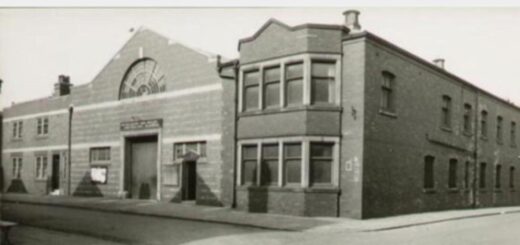
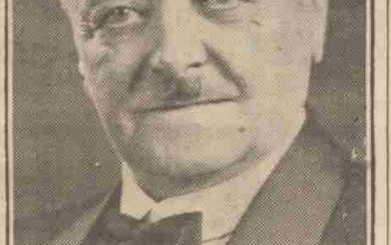
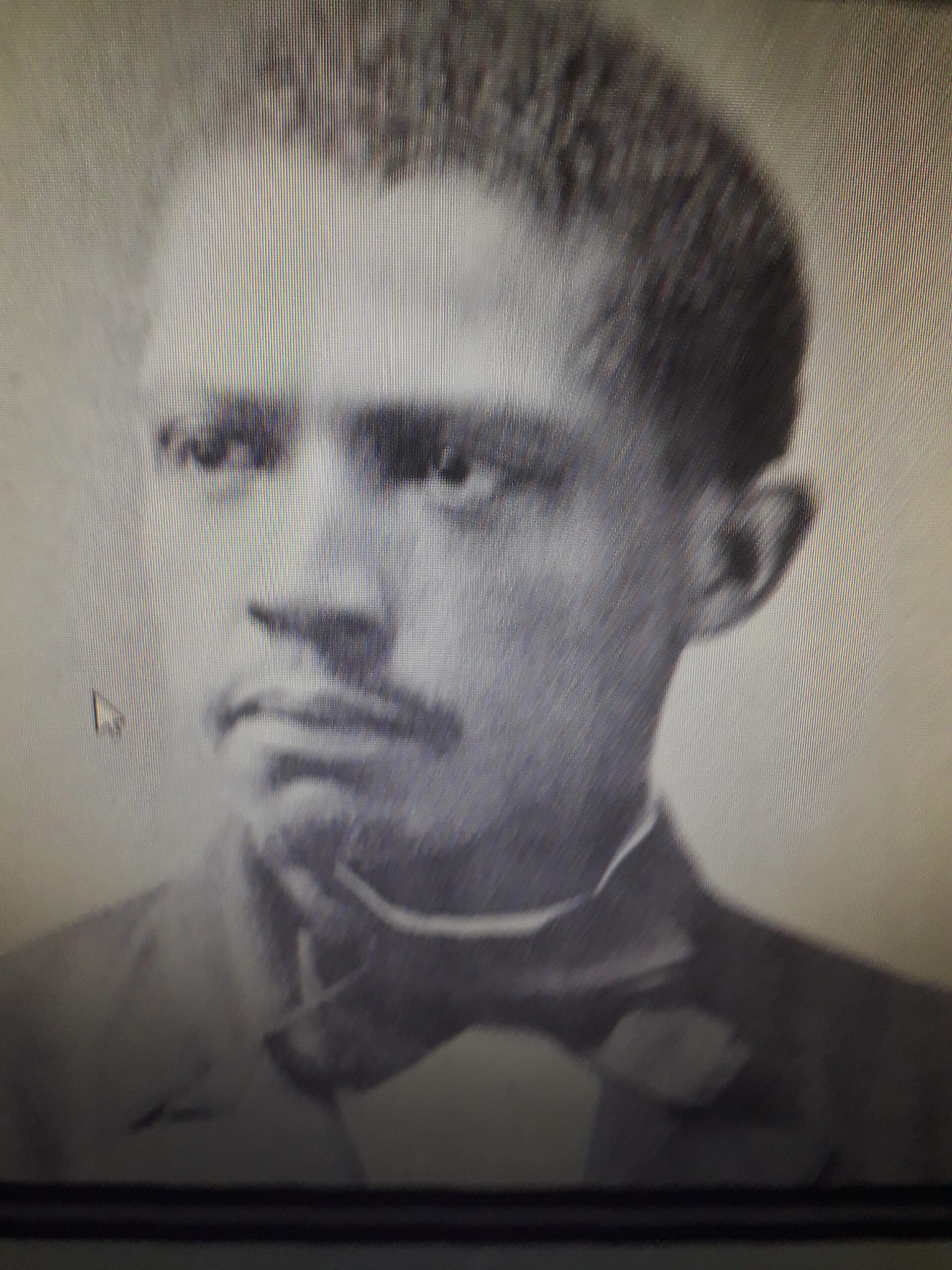
great stuff Colin I vaguely knew about the disturbance in 1930 but it was great to hear details… and so much research… this is the definitive piece about St Stephens.
Hi Martin, thanks for the comment. Most of the work involved is kind of a judicious transcription of the newspaper articles, (once located, which is the bulk of the work and the time!). The disturbance at the church is an interesting side story; as we know, perceptions of perfection are based on deeper perceptions of perfection which are usually based on the perception of ‘Sod off I’m right; you’re wrong’ so there will never be peace in the world! I guess even AI (Intelligence rather than Insemination) will learn to be prejudiced in its own strive for self justification.